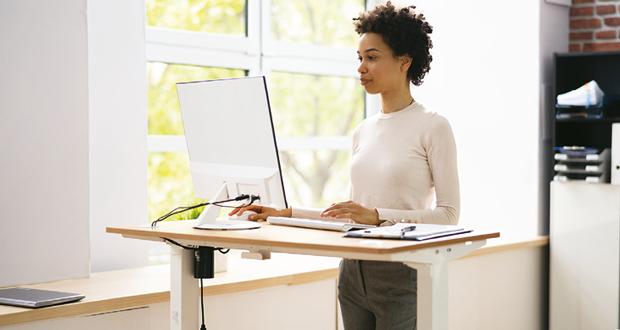The average person sits 12 hours each day, which increases the risk for cardiovascular disease, diabetes, certain cancers and more. With hybrid and remote workers under increased pressure to prove a solid workday, it’s likely that they are working even longer hours at each stretch in front of their devices.
Since uninterrupted sitting negatively impacts employee productivity and contributes to a deterioration in workers’ physical and mental health, employers are searching for better and healthier ways to work that support hiring, employee loyalty and retention. Facilities managers are therefore looking to take a new approach to office design that promotes movement, using flexible tech and office equipment to make a “Sit-Stand Switch”.
WHAT IS THE SIT-STAND SWITCH?
The principle behind the Sit-Stand Switch is that assuming a good posture and keeping active at work will stimulate creativity and productivity while boosting circulation. It will also ensure workers are taking the right breaks from their screen and from long periods of sedentary work. Sit-stand workstation users report more standing, walking and stretching compared with those using traditional desks.
It’s best to start slowly and work up to the Sit-Stand Switch to avoid any unintended physical stress or strain on the body. Workers will start to stand for short periods at a time – five minutes per hour – then work up to the Sit-Stand Switch guideline, which recommends employees spend 30 minutes sitting before alternating to 30 minutes standing throughout the workday. As it adjusts, the body should start to use its own natural cues to switch positions.
MAKING A SIT-STAND SWITCH
There is a three-stage process for designing a sit-stand programme through building mindshare, adopting sit-stand solutions and measuring results that matter:
Step 1: Building mindshare
With millions of workers performing jobs in front of computers and around conference tables, the challenge to break long-term habits and perceptions is greater than ever. It’s time to break the sitting habit and normalise standing.
The first step is to engage leaders throughout the organisation addressing any concerns and demonstrating how a sit-stand programme can help them accomplish their goals. It’s best to engage leaders early to identify programme champions who will lead by example due to understanding the merits themselves.
Step 2: Designing the programme
Once there’s buy-in from the C-suite and key departmental heads, the next step is to design the programme. This requires an effective policy, process and communications.
Creating a policy means defining the transition to movement-friendly workstations and gives every employee a choice about whether or not they adopt a sit-stand desk at their own workstation. The more this offers to support movement in a variety of ways, the more successful the sit-stand programme.
Key policy considerations might include:
- Flexible schedules that allow for workday activity breaks
- Shorter meetings that give employees time to stretch and walk in between
- Mandatory activity breaks during meetings longer than 90 minutes
- Casual dress code to better support standing, walking and movement
It’s important to establish channels to communicate the programme throughout the organisation, outlining the programme rationale, the benefits and participation instructions. The programme should be included in the employee onboarding process and webinars and digital brochures are ideal for educating employees and conducting ongoing training.
Step 3: Measure the results
Before initiating the Sit-Stand Switch, setting up clear goals and metrics can help to determine the programme’s success. As well as justify the initial investment in office equipment. It can quantify the impact of the intervention and fuel further growth.
Goals should be set for programme adoption, usage and employee health, for instance a goal of 50 per cent adoption over three years. By gradually allowing individuals to opt in, this ensures a higher chance of success over the period, while allowing the organisation to budget accordingly.
The usage goal would be to target an overall reduction in sitting time. For instance, a goal of 30 per cent less sitting equals roughly 2.5 hours each day. Fifty per cent would be the ideal to aim for in time. A further goal could address long-term effectiveness, to demonstrate that 90 per cent of those that opt-in continue to using their sit-stand workstation one year later.
Self-reported surveys after three months and after one year are the best way to track the physical and emotional impact of a programme. Metrics could include analysing mood states, like happiness, stress and satisfaction, along with questions around pain or discomfort. Additional measurements could include healthcare costs, chiropractic or osteopath visits, and employee retention.
WORK IMPACTS HEALTH, WHICH IMPACTS PRODUCTIVITY
A less sedentary and more free-moving worker is more likely to be more healthy, satisfied, engaged, productive and loyal. The bottom line is: work impacts health and health impacts engagement and productivity at work. With this in mind, a Sit-Stand Switch programme, which includes adopting adjustable, movement-friendly desks as a key element, can create a more sustainable working cycle, where movement improves engagement, performance and health, which contributes to business success and helps employees thrive. It should be a top priority for organisations of every size and structure.



 The Sit-Stand Switch: Three steps to transition your organisation to sit-stand furniture. By Richard Guy, UK & Ireland Country Sales Manager, Ergotron
The Sit-Stand Switch: Three steps to transition your organisation to sit-stand furniture. By Richard Guy, UK & Ireland Country Sales Manager, Ergotron


